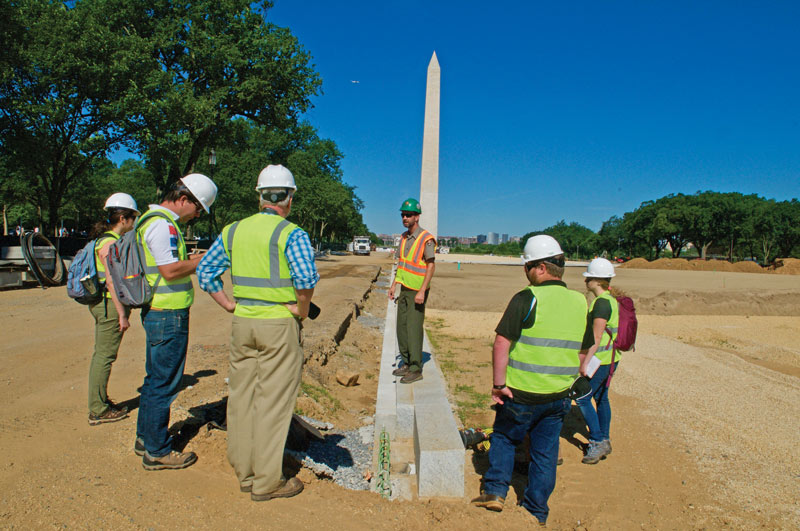
Michael Stachowicz, turf management specialist for the National Mall and Memorial Parks (center, wearing a green hard hat), gives University of Maryland students a firsthand look at the beginnings of the turfgrass renovation on the National Mall in Washington, D.C. Photo by Joseph Roberts
Recently, microbiomes have become a hot topic — often in the context of the microbiome of the human body, which is made up of millions of bacteria, most of which are beneficial. Like human beings, turfgrass systems also have a microbiome; but for turfgrass, many of the microorganisms in the microbiome are found in the soil in which the turf is rooted. Although the turfgrass microbiome is known to be essential to turf health, not much is known about how it reacts to drastic changes such as sod installation or overseeding. Research has shown, however, that both beneficial and harmful microscopic organisms — plant pathogens, nematodes, endophytes — are found in commercial turfgrass seed and sod.
The story of research about the microbiome at the National Mall in Washington, D.C., begins with Michael Stachowicz, turf management specialist for the National Mall and Memorial Parks, whose mission was to restore the turfgrass on the National Mall, and Joseph Roberts, Ph.D., who was beginning his post-graduate career as a faculty member in plant pathology at the University of Maryland in College Park. Roberts realized that an upcoming renovation of the National Mall could provide a laboratory for testing some common assumptions about the reaction of the turfgrass microbiome to a significant disruption. And even though he was taking on a high-profile restoration project, Stachowicz, a former golf course superintendent and 26-year member of GCSAA, was generous in allowing Roberts to take turf samples both before and after renovation.
Initially, Roberts took samples of the existing turfgrass from the Mall and stored them in his freezer while he settled into his new job. A few months later, the research got underway after Jo Anne Crouch, Ph.D., from the U.S. Department of Agriculture’s Agricultural Research Service, suggested the project would be ideal for a high school senior, Zakiya Carter, who was interning in Crouch’s lab.
The original lawn at the National Mall was a mix of several grass species and dicots (pre-renovation samples were mainly Poa annua). The replacement turf — a mix of Turbo, Falcon V and 3rd Millennium tall fescue and Barvette HGT, Bararri, Barimpala and Barrister Kentucky bluegrass developed specifically for the Mall — was grown about 170 miles away from the nation’s capital on a sod farm in New Jersey. Samples were taken from the Mall (both before and after renovation), from the sod farm (tall fescue and Kentucky bluegrass), and from the USDA in Maryland (diverse grasses and dicot plants maintained as an unirrigated lawn).
The hypothesis of the researchers was that, because of the distance between the D.C. and New Jersey locations and the differences in turfgrass composition, the original microbiome of the National Mall turf would be significantly different from that of the replacement sod.
DNA was extracted from the samples and analyzed, and the bacterial community composition was identified for all four locations. To their surprise, the researchers did not find significant differences among the four microbial communities despite the differences in turf types and locations. However, future research that focuses on greater geographical differences and warm-season vs. cool-season grasses may be more likely to show significant differences among microbiomes in turf. Given the findings of this project, the researchers think the sod renovation may not significantly alter the microbial population in the turfgrass at the National Mall.
This research was originally published in the journal Crop Science: The U.S. National Mall microbiome: A census of rhizosphere bacteria inhabiting landscape turf by J.A. Crouch, Z. Carter, A. Ismaiel and J.A. Roberts. 2017. Crop Science 57: supplement 1: S-341-S-348. doi: 10.2135/cropsci2016.10.0849.
Teresa Carson is GCM’s science editor.